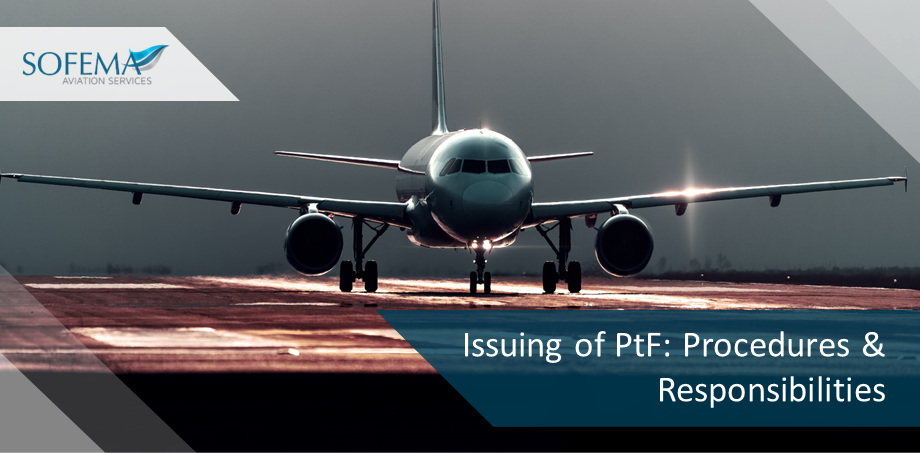Permit to Fly оverview presented by Sofema Aviation Services (SAS) www.sassofia.com
Introduction
EASA is responsible for the approval of flight conditions. Such an approval is the basis on which a Permit to Fly (PtF) can be issued by the Competent Authority of the State of Registry, or of the State prescribing the identification marks of an aircraft.
Note: A PtF is issued on the basis of approved flight conditions, and these will identify the applicable limitations.
- A PtF is generally issued when a certificate of airworthiness is temporarily invalid, or when a certificate of airworthiness cannot be granted, but the aircraft is nevertheless capable of performing a safe flight.
- A PtF is required when an aircraft does not meet, or has shown not to have met, applicable airworthiness requirements and as a result does not hold a valid certificate of airworthiness or restricted certificate of airworthiness, but is capable of a safe flight under defined conditions and for the purposes listed on point 4.2 of Form 37
Note: The State of Registry can also grant an exemption to allow an aircraft to fly without a valid C of A or R-C of A under the provisions of article 14.4 of the Basic Regulation if it finds that the conditions of this article are met.
- In accordance with Part 21 A.711, the Competent Authority of the State of Registry is responsible for the issue of a PtF.
- Approved design or production organisations may also issue a PtF within limitations specified in Part 21.
Note Concerning Part CAMO / Part CAO Organisation
- An organisation holding the Airworthiness Review Certificate privileges may additionally be approved to issue a permit to fly in accordance with point (d) of point 21.A.711 of Annex I (Part-21) to Regulation (EU) No 748/2012 for the particular aircraft for which the organisation is approved to issue the airworthiness review certificate, when the organisation is attesting conformity with approved flight conditions, subject to an adequate procedure in the CAME referred to in point CAMO.A.300.
Who Can Approve Flight Conditions?
In accordance with Part 21 A.710, EASA is responsible for the approval of flight conditions where they relate to safety of the design.
- However, certain DOA holders may have the privileges to approve flight conditions related to safety of the design.
- Where the flight conditions are not related to safety of the design, they may be approved by the Competent Authority.
EASA approves the flight conditions in cases related to the safety of the design, defined as follows:
- the aircraft does not conform to an approved design1; or
- Typical conditions include, but are not limited to
– unapproved modifications/STCs;
– damage beyond SRM limitations, not repaired or treated by a temporary fix combined with limitations;
– functional deficiencies or defects not covered within MMEL, and
– missing parts not covered within the CDL.
– an Airworthiness Limitation, a Certification Maintenance Requirement or an Airworthiness Directive has not been complied with; or the intended flight(s) are outside the approved envelope.
When is EASA typically not involved?
- When the approval of flight conditions is not related to the safety of the design, the Agency is not involved, but only the Competent Authority of the State of Registry, or of the State prescribing the identification marks.
- Examples of such conditions are:
1. production flight testing for the purpose of conformity establishment;
2. delivery/export flight of a new aircraft the design of which is approved;
3. demonstrating continuing conformity with the standard previously accepted by the Agency for the aircraft or type of aircraft to qualify or re-qualify for a (restricted) certificate of airworthiness.
Application for PtF
- Not covered by MMEL, CDL.
- Contact CA to start the process for the issue of a PtF
o Related to Safety of Design?
- No? then ok for CA to process
- Yes? Then flight conditions will need to be approved either by EASA, or by a suitably approved DOA.
- Note: In many cases the TC holder will have privileges to do this, based on previously approved flight conditions agreed with EASA.
If the flight conditions cannot be approved either by the Competent Authority or by a DOA, then an application to EASA using Form 37 will be necessary.
EASA will require:
- Technical data to support the application which identifies the defective condition
- Actions taken to minimise the effects (e.g. statement from the manufacturer supporting the flight), and
- Proposals for the flight conditions (using Form 18b) that further mitigate the situation in order that it can be clearly determined that a safe flight can be performed.
Note: Where it is known that flight conditions will need to be approved by EASA, application for these could be made in parallel with the application to the Competent Authority for a Permit to Fly.
Next Steps
Follow this link to our Library to find & Download related documents for Free.
Sofema Aviation Services provides the following course as Classroom or Webinar training: Managing EASA Maintenance Check Flight (MCF) and Permit to Fly (PtF) Requirements – 1 Day
Please see www.sassofia.com or email team@sassofia.com
Tags:
aircraft design, airworthiness directive, Airworthiness Review Certificates (ARC), Approval, aviation, aviation safety, Aviation Training, Basic Regulation, CAME, Competent Authority (CA), DOA holders, EASA, EASA Part CAMO Organisation, EASA Part-CAO, Flight, flight conditions, Permit to Fly, SAS blogs, Sofema Aviation Services, State of Registry




